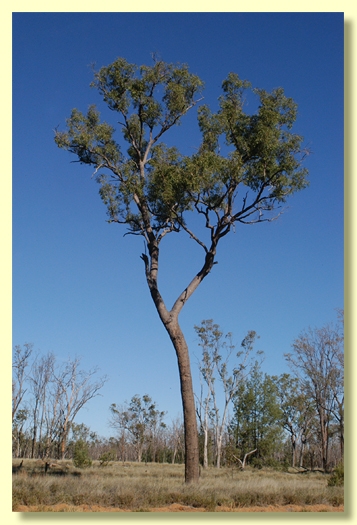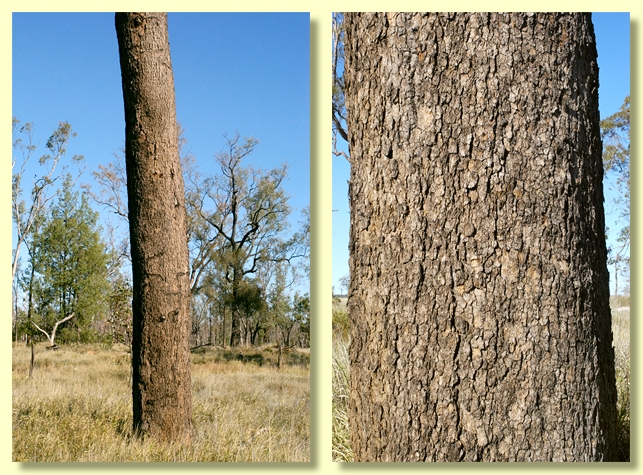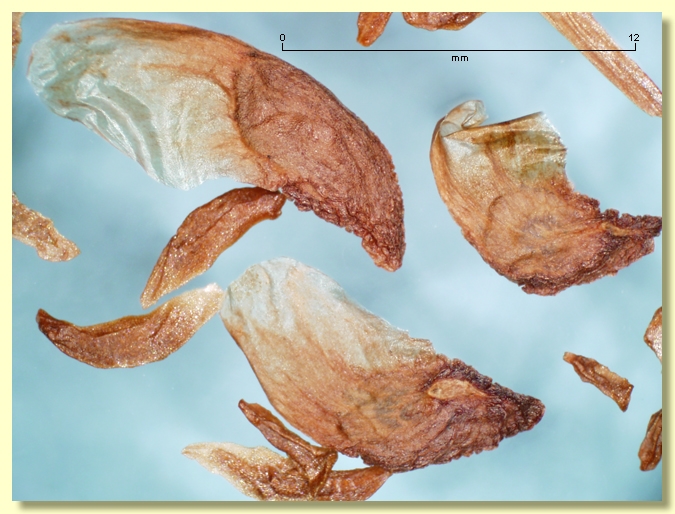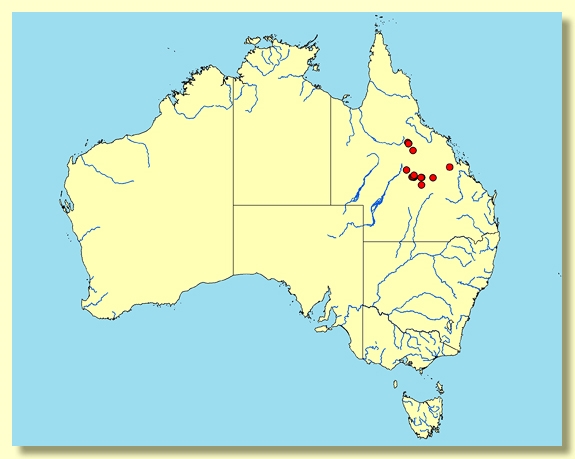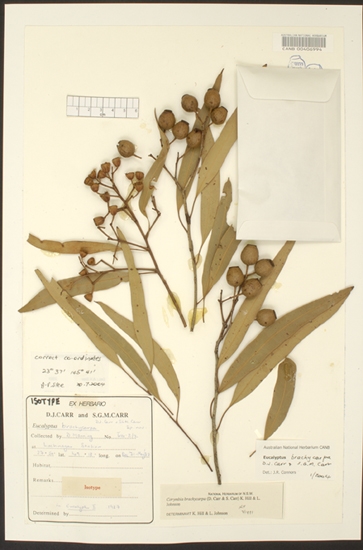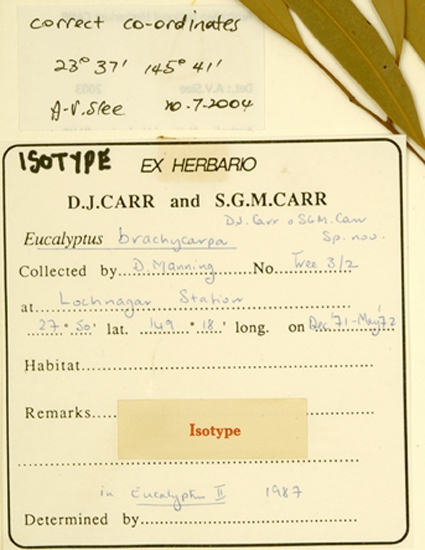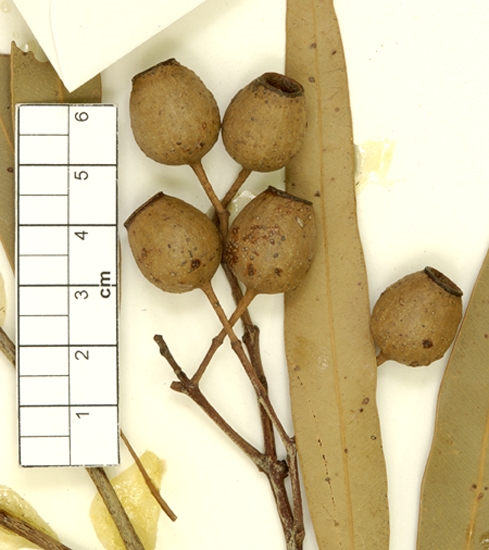Corymbia | Rufaria
Euclid - Online edition
Corymbia brachycarpa
Corymbia brachycarpa (D.J.Carr & S.G.M.Carr) K.D.Hill & L.A.S.Johnson, Telopea 6: 281 (1995).
Tree to 15 m tall. Forming a lignotuber.
Bark rough over trunk and branches to ca 2 cm diameter, deeply tessellated, dark brown to red-brown to orange and brown-grey.
Branchlets smooth; lack oil glands in the pith.
Juvenile growth (coppice or field seedlings to 50 cm): stems rounded in cross-section, smooth; juvenile leaves always shortly petiolate, opposite for ca 30 nodes, linear-oblong to narrowly lanceolate, 7–11.5(15) cm long, 0.4–1.1(1.5) cm wide, base tapering to petiole, apex pointed, dull, green, discolorous, glabrous.
Adult leaves alternate, petioles 1–3 cm long; blade lanceolate, (6.5)8–15 cm long, 0.9–2.1 cm wide, base tapering to petiole, margin entire, apex finely pointed, strongly discolorous, usually dull to slightly glossy, dark green above, paler below, smooth, side-veins greater than 45° to midrib, reticulation dense to very dense, intramarginal vein present but very close to margin and more easily seen from underside, oil glands obscure or sparse and island.
Inflorescence terminal compound, peduncles slender 0.3–1.6 cm long, buds in umbels of 7, pedicels 0.2–1.2 cm long. Mature buds obovoid to pyriform (ca 0.6 cm long and 0.5 cm wide), glossy, scar absent (both opercula shed together at flowering), operculum shallowly rounded to conical, stamens inflexed, all fertile, anthers oblong, dorsifixed, versatile, dehiscing by longitudinal slits, style long and straight, stigma blunt, locules 3 or 4, the ovules not arranged in clear rows on the placentae; flowers creamy white.
Fruit pedicellate (pedicels 0.5–1.2 cm long), urceolate to ± barrel-shaped, not flared at the rim, 1.3–1.8 cm long, 1–1.5 cm wide, longer than wide, ± smooth, disc descending vertically, valves 3 or 4, enclosed.
Seeds brown, 8–11 mm long, ellipsoidal with terminal wing, hilum ventral
Cultivated seedlings (measured at ca node 10): cotyledons reniform; stems rounded in cross-section, setose with short bristle-glands only at lowest nodes to ca node 3, otherwise smooth; leaves sub-sessile to shortly petiolate, opposite, linear-oblong, 5–10.3 cm long, 0.6–1.3 cm wide, base tapering to petiole, green, darker upper surface slightly glossy by node 10, sparsely setose only on lowest leaves, soon becoming free of setae.
Flowering time not recorded.
Bloodwood tree endemic to central Queensland, found in the area from the southern end of the White Mountains and Suttor River hinterland south to between Barcaldine and Alpha, extending south to the Enniskillen Range near Blackall, with an eastern outlier on the Junee Tableland east of Clermont. It prefers fairly deep sands over sandstone or laterite. Corymbia brachycarpa has thick brownish coarsely tessellated bark throughout and a crown of green dull to slightly glossy, discolorous leaves being darker green above, paler below, shiny buds that are clearly pedicellate and ± linear-oblong, glabrous, green juvenile leaves.
Within its natural range C. brachycarpa might be confused with several other rough-barked bloodwoods with discolorous leaves, particularly C. hendersonii, C. plena, C. lamprophylla and C.clandestina. C. hendersonii has larger, thicker fruit and glossier adult leaves than C. brachycarpa. Both species have smooth buds. C. plena differs from C. brachycarpa in having scurfy plump buds, and larger fruit with a thick rim and thick wall, though both species have dull or sub-glossy adult leaves. C. lamprophylla has smooth buds and similar-sized fruit to C. brachycarpa but differs in its strikingly glossy adult leaves and juvenile leaves that remain setose for longer. The rare and poorly known C. clandestina differs from C. brachycarpa in having smaller fruit and glossy adult leaves.
MORE ABOUT CORYMBIA
MORE ABOUT RED BLOODWOODS
Corymbia brachycarpa: Greek brachy, short and carpos, fruit, referring apparently to the relatively short fruit which are about middle-sized when compared with those of many species.


